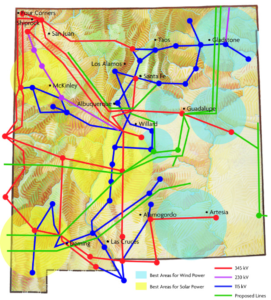Distributed micropower is delivered power.
A major decision for the nation’s energy future needs more conversation. Should we build centralized (aka central-station) energy systems or should we concentrate on decentralized (aka distributed) energy systems?
Centralized Power Systems
Centralized systems start with big and distant power plants and high voltage transmission lines.

Decentralized Power Systems
Decentralized systems generate power on rooftops or in near-by energy parks with no or short transmission. (They, of course, have distribution lines.)

Benefits of Distributed Power
This new configuration of micropowers and microgrids has many benefits over the old configuration (a big power plant feeding superhighway transmission lines). It reduces toxic and greenhouse gas emissions. It saves land, protects property rights, and reduces controversies over rights of way and eminent domain. It is more efficient, eliminating line-loss inefficiencies and the water required for cooling large power plants. It can resolve peaking power problems and postpone the need for new power plants and transmission lines. It avoids financing problems for large power plants and high-voltage lines — the capital, taxes or bonds otherwise required. It is frugal.
Distributed micropower is delivered power.
How Micropower Plants Work
Micropowers vary from 4kW to 10 MW. They can be built on-site or nearby in energy “parks” of solar, wind or geothermal (“load-size generators”). Among European businesses, high efficiency combined-heat-and-power (CHP) and industrial energy recycling have blossomed as sources for on-site power. Micropower renewables include small solar photovoltaic arrays and roof shingles, plug-in hybrid vehicles, micro-CHP, micro-hydro, ground heat-storage, wood waste generators, renewable-energy-powered fuel cells, geothermal, and small wind turbines on roofs. Increasingly popular are thermal-based engines and steam turbines from biofuels and biogases as well as gas turbines and micro-turbines.
Micropower “islands” could be among the largest sources of New Mexican electricity. In the dream, New Mexico transforms the existing metering architecture to a system that allows re-metering, a two-way feed of electrons, profits and costs between private citizen and the bulk-providing utility. Islands of multi-modal renewables (with a few gas turbines) can share each others electricity production, feeding excess to the Big Green Grid, and using the Big Grid only as back-up in emergencies and periods of heavy loads. Building owners can earn profits from selling “green” electrons back to the bulk utility.
Microgrid for New Mexico

Micropowers could be one of the largest sources of New Mexico electricity — with the right incentives, political will and local governmental enthusiasm. Covering the roofs of buildings, they can supply daily needs and make the owner money by feeding energy back to grid.
Learn about microgrids:
